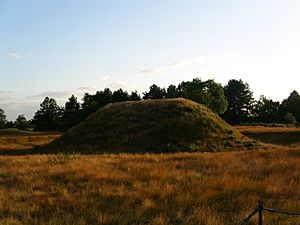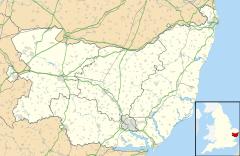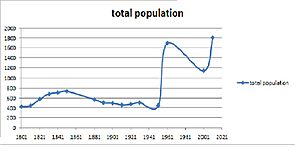Sutton, Suffolk facts for kids
Quick facts for kids Sutton |
|
|---|---|
| Population | 1,804 (2011) |
| OS grid reference | TM305455 |
| Civil parish |
|
| District |
|
| Shire county | |
| Region | |
| Country | England |
| Sovereign state | United Kingdom |
| Post town | Woodbridge |
| Postcode district | IP12 |
| Dialling code | 01394 |
| Police | Suffolk |
| Fire | Suffolk |
| Ambulance | East of England |
| EU Parliament | East of England |
| UK Parliament |
|
Sutton is a charming village and civil parish located in the East Suffolk area of Suffolk, England. You can find it along the B1083 road. Sutton has a local pub, a mobile post office, and a church. Nearby, you'll also find the small area called Sutton Street and the Sutton Common estate.
Contents
History of Sutton
The name "Sutton" comes from Old English words. Sut means "south," and ton means "farmstead" or "settlement." So, Sutton basically means "Southern Farm."
The oldest official record of Sutton is found in the Domesday Book, which was written way back in 1086. This book tells us that 77 families lived in Sutton at that time. The main person in charge of Sutton back then was a lord named Robert Malet.
Jobs in the Past
In 1831, about 680 people lived in Sutton. Most families, around 100 out of 126, worked in farming. This was very common in the area. A famous writer named Arthur Young visited Suffolk in 1784. He wrote about a big farmer in Sutton, Mr. William Waller, who managed 2,700 acres of land and had over 1,000 sheep!
Back then, most people in Sutton were laborers or servants. Only a few people owned small farms. This shows how different jobs and social classes were in the past compared to today.
Churches in Sutton
All Saints' Church
The All Saints' Church was built in 1555. It was later rebuilt quite a bit by people in the Victorian era. This old church has a special font (a basin for baptisms) that is even older than the church itself. It's from before the Reformation, which is interesting because the church is now part of the Church of England. This font is one of the few things left from an even older church that burned down in the 1600s.
Some notable people buried in the churchyard include:
- Edith Pretty (1883–1942): She was the landowner on whose property the famous Sutton Hoo burials were discovered.
- Brian Forster Morton Franks (1910–1982): He was a brave soldier who fought in World War II. He was part of the Special Air Service (SAS) and worked for the Secret Intelligence Service. He received several awards for his bravery, like the MC and the DSO.
Baptist Chapel
There is also a smaller Baptist church in Sutton, known as the Chapel. It's located on Main Road and was first started in 1813.
War Memorial Hall
In 1954, a special building called the Memorial Hall was built. It was made to remember all the soldiers from Sutton who fought in the Second World War. Local people worked together to build it, helping with everything from plastering walls to buying curtains. The hall officially opened on October 30, 1958.
Sutton Today
Sutton is located between the River Deben and Rendlesham Forest. The famous Sutton Hoo estate, known for its ancient ship burial, is just north of the village. In 2011, the village had a population of 1,804 people.
According to the 2011 census, many people in Sutton work in professional and technical jobs, especially in protective services like police or fire departments.
In Sutton, you'll find the Memorial Hall (which is like a town hall), a pub called the Plough Inn, the All Saints Church, and the smaller Baptist Chapel. Nearby, you can visit tourist spots like the Sutton Hoo burial site, Rendlesham Forest, and the River Deben.
Memorial Hall Activities
The Memorial Hall is a busy place where many community groups meet. There's a ladies' group that meets every second Thursday, and a computer group. You can also take Pilates and dance classes there.
Behind the hall is a recreation ground. The Sutton Heath Football Club uses this ground for their Under-14 and Under-12 teams. Their old field was too small for all their players. There's also a local bowls club that plays on the green at the recreation ground. They even received a special grant to fix up their hut for a tournament!
Rendlesham Forest Adventures
Rendlesham Forest is a huge forest, about 1,500 hectares in size. It's owned by the Forestry Commission, who have created many walking and cycling trails, fun events, and play areas for everyone to enjoy.
Rendlesham Forest is also famous for something unusual that happened in 1980. It was the site of a reported UFO sighting, known as the Rendlesham Forest incident.
In 2012, a new boundary was made for the parish. Some residents asked the council to create a new parish in the north-east part of Sutton. This new area is called Sutton Heath. It was created because it's more like a town than the rest of Sutton and has different needs.
Sutton Hoo: An Ancient Discovery

The Sutton Hoo Estate covers 225 acres and is home to an amazing discovery: the burial site of an Anglo-Saxon ship! In 1940, an archaeologist named Basil Brown, working for the landowner, found this incredible Anglo-Saxon burial. Many people believe it's the final resting place of Rædwald, a king of East Anglia.
Most of the treasures found at Sutton Hoo are now kept in the British Museum. The burial site is now owned by the National Trust and is a very popular place for tourists to visit. It has a café, parking, and a gift shop.
Sutton Hall
Sutton Hall is a beautiful Georgian country house with large grounds located south of the village. It used to be the home of Sir Guy Quilter. In 2018, it was sold for a lot of money, over £31.5 million!
Bentwaters: A Former Air Base
RAF Bentwaters is a military base that is no longer active. It's located in Rendlesham Forest. The site is now owned by a family business called Bentwaters Parks. They rent out the military-style buildings at RAF Bentwaters to companies that want to film movies and TV shows there.
This military base was one of the last ones built before World War II ended. The area was chosen because it was flat and didn't have many people living there, which was perfect for building the long runways needed for planes. The base had a big effect on Sutton's population. When it opened in 1941, many men came to work there, and Sutton's population grew a lot, as you can see in the population graph.



